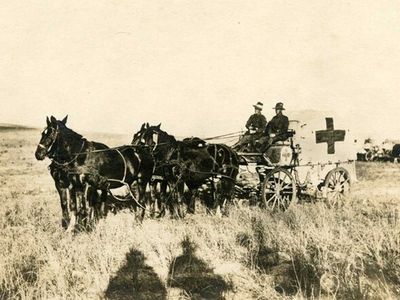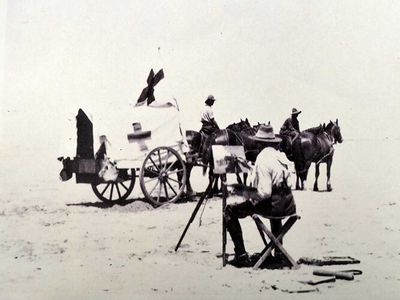“Major Avery, among many other Old Boys, holds a special place on the TGS Old Boys’ Wall of Achievement for his role in inventing the “Rapid Transit Ambulance” that was a key part of the Australian Light Horse Brigade.”

On ANZAC Day, we come together to reflect on the importance of service and sacrifice.
Toowoomba Grammar School would like to acknowledge our admiration for the loyalty, service and bravery exhibited by TGS Old Boys who so valiantly served. We are all the beneficiaries of their sacrifice, and their selfless actions continue to inspire a spirit of service amongst our current students.
Today we focus on the contribution of one TGS Old Boy who made a significant contribution to World War I. Here is some of the incredible story of Major Avery, DSO and if you visit the School Museum and Archives you can see a display in his honour.
Much of this history has been captured through countless hours of dedication and devotion by current TGS museum volunteer and former TGS staff member, Mrs Ann Hallam who managed the School’s Cadet Unit from 2006-2019.
Major Avery DSO, inventor of the WWI “Rapid Transit Galloping Ambulance”
Distinguished TGS Old Boy, Leonard Grimes (1880-1885) was born in Queensland in 1869 and died in 1953. Grimes attended the School in the days of Sir Harry Chauvel and Sir Littleton Groom and while at TGS was known as Leonard Avery Grimes.
After his School days he went on to Wadham College, Oxford, where he graduated with a medicine degree. He later changed his name to Conrad Avery and after some years as a hospital physician and surgeon, Avery enlisted with the British Army and joined the Suffolk Imperial Yeomanry. He was later promoted to Major and joined the Royal Army Medical Corps. During World War I he was enlisted with the Royal Westminster Dragoons and served in Palestine, Egypt and Syria.
Major Avery, among many other Old Boys, holds a special place on the TGS Old Boys’ Wall of Achievement for his role in inventing the “Rapid Transit Ambulance” that was a key part of the Australian Light Horse Brigade.
Light Horse Field Ambulance
The Light Horse units were mounted infantry with efficient mobile medical support to the wounded and sick soldiers of an Australian Light Horse Brigade. The Field Ambulance ensured the removal of the wounded from the front line to the advanced dressing station where there were surgical and resting tents.
These sand carts had two wheels with tyres that were wide enough to stop the cart digging into soft sand and could carry two or three stretchers. In heavy sand four horses were necessary to pull the cart, and the cart had to be steered by a rider on one of the lead horses.

Australian Light Horseman
The 2nd Light Horse Field Ambulance was formed in Brisbane with much of the unit coming from Queensland.
More than 15 TGS Old Boys enlisted with the Second Light Horse Brigade, two of whom died at Gallipoli: Major Dugald Maxwell Lockwood Graham and Trooper Gordon Holmes Robertson.
During the World War I, George W. Lambert (1873-1930) served Australia as an Official War Artist attached to the ANZAC Mounted Division. He spent two terms in service, the first with the Light Horse in Palestine, and the second in Gallipoli and Egypt before his military contract discharge.
As a result of Lambert’s service during World War I, he was offered a variety of commissions to paint scenes from significant war time events, including an activity of the 2nd Australian Light Horse Field Ambulance, Walk (An Incident at Romani).
The Battle of Romani was the last ground attack on the Suez Canal at the beginning of the Sinai and Palestine Campaign. The battle was fought from 3 to 5 August 1916 near the Egyptian town of Romani.
The completed painting was to be given to the Queensland (National) Art Gallery by the Light Horse in memory of their fallen comrades.
The Rapid Transit Ambulance
Major Avery describes his vision for a new galloping ambulance, known as “The Rapid Transit Ambulance”.
This ambulance was designed with a view to filling the want of stretcher bearers with mounted troops. The endeavor has been to construct a light strong carriage easily adjustable to any mounted horse and capable of keeping up with cavalry through any sort of country. As will be seen from the accompanying illustration, the ambulance is a two-wheeled contrivance.
The body consists of a platform fixed to a crank axle by long springs between 46-in. wheels. This platform is 2 ft. 3 in. from the ground and is arranged to carry an ordinary service stretcher. The forepart consists of a pair of short shafts which are attached to the body by an arrangement of springs adapted to prevent the side-to-side motion caused by the action of the horse. The shafts reach as far forward as the saddle flaps, where they are held in position by a girth strap, breastplate, and belly-band.
The body is covered by a canvas hood. The weight is about 3 cwt. Length overall, 12 ft. Track, 4ft. 1 in. Surgical dressings, splints, water-bottle, &c., are carried. It is quite easy for the driver, having placed a wounded or helpless man in a stretcher, to transfer him from the ground to the platform of the carriage single-handed.
This ambulance has been on duty with the Suffolk, Sussex, Surrey and Middlesex Imperial Yeomanry during their respective training, and with the Wiltshire Yeomanry through the recent maneuvers. It is a very comfortable conveyance and has proved capable of negotiating with almost any country.
Walk (An Incident at Romani)
The incident to which Lambert’s painting refers occurred during the Battle of Romani on 4 August 1916. The 2nd Light Horse Field Ambulance had deployed two sand-carts to an exposed part of the line to retrieve some seriously wounded men. Upon its return journey the Field Ambulance envoy came under Turkish fire and its panicked horses started to bolt.
Tragedy was averted when the corporal signaled ‘Walk’ and galloped to the front of the party to steady the teams. After the horses had been calmed and resumed their pace, the enemy apparently recognised the Ambulance’s mission and averted their fire. As a result of their bravery and composure during the incident the corporal and drivers were awarded Military Medals.

To enable Lambert to make sketches of the event that was already three years in the past, it was re-enacted at Kantara, Egypt in 1919. Photographs were taken of Lambert at work sketching this re-enactment. The completed painting portrays the moment when the corporal signals ‘Walk’ whilst rushing to the front of the group to steady the bolting teams.
Remembrance Day
Remembrance Day marks the anniversary of the Armistice which ended the First World War, signed at 11:00am on 11 November 1918. We still remember those who have given their lives in conflict before and since, by taking a minute to stop, be silent and remember the war that was to end all wars.
Latest Blog
Holiday Reading Recommendations
Here is a snapshot; three titles from each year level, and from Head of Library and Information Services, Mr Dan Crook to inspire your choices for holiday reading: Year 7: Teenage Mutant Ninja Turtles - The last Ronin. Hatchet - Gary Paulsen Billy Slaters autobiography - Billy Slater Year 8: The dead of the night (Tomorrow series) - James Marsden Rangers Apprentice The ruins of Gorlan - John Flannagan The Hunger games. -Suzanne Collins Year 9: Back to the Pillaga - Tony Parsons Deadpool Samurai…
Life After School
As children grow and develop, they participate in a range of new experiences, with the “journey” from birth to adulthood being shaped by several awaited and expected transitions. These transitions occur across a range of context and help us to evolve in new environments. It is important to note that transition is associated with a change, which is something that happens for all of us. The concept of transition involves how we process, manage, and respond to the change. As adults, we work hard…
TGS Artist in Residence - Ben Tupas
I’ve been following Toowoomba Grammar School’s exciting Artist-in-residence program for several years. After seeing fellow Toowoomba artists such as Catherine Parker, Alice Weinthal and Vincent Parisi taking up the opportunity and engaging in the program, I decided to apply in 2022 to continue the momentum of my own artist practice. With the four-week residency wrapping up at the end of October, and some time to reflect on the experience I can write that the experience was a valuable…
The Transition to Secondary School
Research shows us that the move from a primary school to a secondary school is one of the most significant life changes that our young men will face. You can help make the transition to Senior School smoother by ensuring that the boys attend the orientation days, practice packing their bags and getting their sports, music, and activities equipment ready. When asked about tips for the boys coming into Year 7, current Year 7 dayboy, Ollie Wells suggests boys should “Be organised. Pack the night…
Nothing is Impossible
Toowoomba Grammar School's Year 7C English has been studying 'Cool Runnings' to learn about how stories or movies based on real life aren't always completely true. Extremely fascinated by the topic, young student Harry Ryan took it upon himself to message (via LinkedIn) the bobsled driver, Mr Dudley Stokes - he responded! After a little communication between the two, Harry asked Mr Stokes if he could FaceTime him during an English lesson, to 'meet' his teacher Mr Paul Irwin and classmates…
Simple Acts of Kindness
Giving back to the community is an important value that Toowoomba Grammar School endeavours to instill in our boys. Year 12 student, Tumoana Strugnell is a shining example of how it costs nothing but our time to help others, especially as we move into the Festive season and the challenges of life seem heightened. I first became involved in community service when I was in Year 6, through my local primary school’s involvement on ANZAC Day and my parent’s involvement in local community events. I’m…
A Holistic Approach to our Boarders' Activities Program
A true education is about much more than just lessons in a classroom. It’s about providing experiences that challenge a child, physically and mentally. It’s about providing opportunities that build independence, resilience and that help develop their good character. Toowoomba Grammar School is proud to offer a broad and liberal education that stretches way beyond the walls of a classroom and equips our boys with the skills to flourish as an individual. We offer a diverse and engaging…
A Beginner's Guide to Manga
If your son has brought home a book with big eyed characters, and he seems to be reading backwards, chances are, he's discovered Manga. The Dent library has a Manga collection that would be the envy of many schools, with over 100 unique titles. It Is easily the most visited section in the library, over half of the top 100 titles borrowed this year are Manga! But what is Manga? Manga is an umbrella term for a variety of print comics and graphic novels originating from Japan. Unlike western…
A Safe, Welcoming and Joyous Community
Tell us about yourself My background, at least that associated with boarding and teaching, is long and varied with a number of different aspects leading to this chosen career path. For the most part, I was schooled in Canberra but had extended periods in Lesotho, Norfolk Island, and Samoa as a result of my father’s work in foreign aid. My schooling was quite disruptive, and I wasn’t a model student! I was always passionate about English; often distracting myself (amongst other things) immersed…